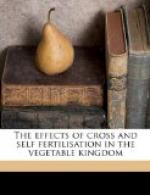6. Dianthus caryophyllus.
Plants self-fertilised for three generations were crossed with pollen from a fresh stock, and their offspring were grown in competition with plants of the fourth self-fertilised generation. The crossed plants thus obtained were to the self-fertilised in height as 100 to 81, and in fertility (both lots being left to be naturally fertilised by insects) as 100 to 33.
These same crossed plants were also to the offspring from the plants of the third generation crossed by the intercrossed plants of the corresponding generation, in height as 100 to 85, and in fertility as 100 to 45.
We thus see what a great advantage the offspring from a cross with a fresh stock had, not only over the self-fertilised plants of the fourth generation, but over the offspring from the self-fertilised plants of the third generation, when crossed by the intercrossed plants of the old stock.
7. Pisum sativum.
It has been shown under the head of this species, that the several varieties in this country almost invariably fertilise themselves, owing to insects rarely visiting the flowers; and as the plants have been long cultivated under nearly similar conditions, we can understand why a cross between two individuals of the same variety does not do the least good to the offspring either in height or fertility. This case is almost exactly parallel with that of Mimulus, or that of the Ipomoea named Hero; for in these two instances, crossing plants which had been self-fertilised for seven generations did not at all benefit the offspring. On the other hand, a cross between two varieties of the pea causes a marked superiority in the growth and vigour of the offspring, over the self-fertilised plants of the same varieties, as shown by two excellent observers. From my own observations (not made with great care) the offspring from crossed varieties were to self-fertilised plants in height, in one case as 100 to about 75, and in a second case as 100 to 60.
8. Lathyrus odoratus.
The sweet-pea is in the same state in regard to self-fertilisation as the common pea; and we have seen that seedlings from a cross between two varieties, which differed in no respect except in the colour of their flowers, were to the self-fertilised seedlings from the same mother-plant in height as 100 to 80; and in the second generation as 100 to 88. Unfortunately I did not ascertain whether crossing two plants of the same variety failed to produce any beneficial effect, but I venture to predict such would be the result.
9. Petunia violacea.




